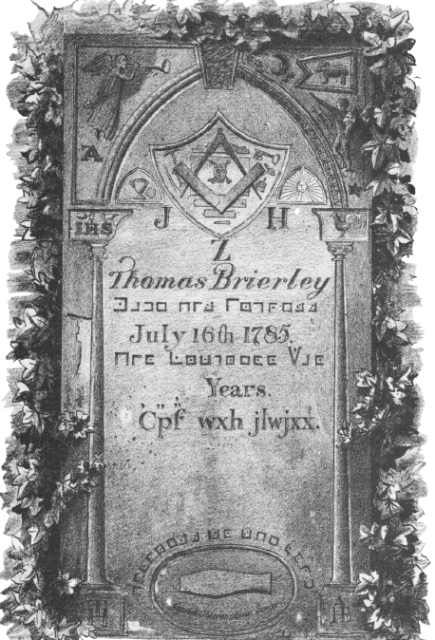There is much in Mellor that is ‘special’ - the views, the church, Mellor Mill - but very little that is genuinely ‘unique’.
 One feature that is truly unique is the Masonic grave of Thomas Brierley, the eccentric printer from Brookbottom, near Strines. A very enthusiastic, though somewhat eccentric, mason, he arranged for a gravestone to be prepared for him in anticipation of his death. Parts of the inscription were written in cipher and other parts left blank because information of the date of his death were not known when the memorial was made.
One feature that is truly unique is the Masonic grave of Thomas Brierley, the eccentric printer from Brookbottom, near Strines. A very enthusiastic, though somewhat eccentric, mason, he arranged for a gravestone to be prepared for him in anticipation of his death. Parts of the inscription were written in cipher and other parts left blank because information of the date of his death were not known when the memorial was made.
He used a very old, yet simple, cipher known as the pigpen cipher. It was used by Cornelius Agrippa and other mystics as early as the sixteenth century and they often used the Hebrew alphabet for their purposes. It was later used by the Rosicrucians and the Freemasons but for purely cryptic purposes. Beginning in the early 18th century, they used it to keep records of their history and their rites private and for correspondence between lodge leaders. From there some masons decided to inscribe it on their tombstones.
One of the earliest examples is in Trinity Church in New York with the inscription “memento mori” (remember death). So, although not absolutely unique, Thomas Brierley’s tombstone is the only one known in the UK. The tomb can still be seen against the south wall of Mellor Church though it is sadly deteriorating. Some of the letters are now eroded but we have a drawing made in 1899 by Joel Wainwright which is clear enough.
So, what does it say? Although the cipher is quite simple, Thomas used several variations on the idea to make it rather more difficult. The first line of code immediately under the name “Thomas Brierley” can be read by using these substitutions.

The second line, underneath “July 16th 1785”, uses a different configuration of substitutions:

With the third line, underneath the word “Years” he uses yet another variation, a straightforward letter substitution. However, just in case you think it is too easy, he uses different substitutions for each of the three words:
 Finally, the symbols inscribed around the coffin at the base of the memorial use the first substitution shown above.
Finally, the symbols inscribed around the coffin at the base of the memorial use the first substitution shown above.
So, have you worked it out by now? I hope so. It would be a tribute to an unusual and interesting person.
He died in 1854 but sadly, after his death, no one was sufficiently interested to fill in the details. perhaps it is just as well. It is a nice touch that something can remain unsolved.
For those who don’t have the patience (or perhaps the mental capacity) to work out the full text, you can find it by scrolling down, below the gallery.
Neil Mullineux, April 2018
Photos: David Burridge






